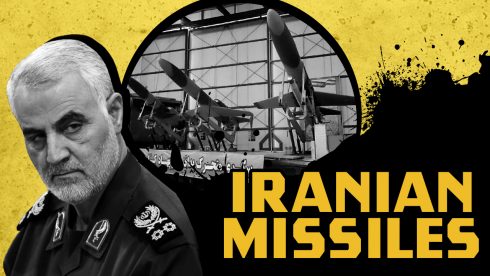The Iranian Ministry of Defense unveiled on May 4 a new precision-guided solid-fueled ballistic missile following threats by Israel.
The missile, dubbed “Qassem Basir,” was showcased during a state TV interview with Defense Minister Aziz Nasirzadeh. He said it includes improvements in both guidance and maneuverability to overcome layers of defense and easily bypass anti-ballistic defense systems.
The television described the missile as having a range of at least 1,200 kilometers. It also said that the missile can identify and strike a designated target among multiple ones without satellite guidance and with pinpoint accuracy. The missile has already gone through a series of tests, the latest of which took place on April 17.
Video footage shown during the interview revealed that the Qassem Basir is a derivative of the Haj Qasem, which was unveiled in 2020 and is said to have a range of up to 1,400 kilometers.
Both missiles are named after Islamic Revolutionary Guard Corps (IRGC) commander Qasem Soleimani, who was assassinated by the United States earlier in 2020.
While Haj Qasem relies only on a satellite-aided inertial navigation system, Qassem Basir appears to be equipped with an optical seeker for guidance at its terminal phase. The seeker likely supports some digital scene matching system. This would indeed make the missile resilient to jamming and more accurate.
The unveiling of the missile came just hours after Prime Minister Benjamin Netanyahu said that Israel will respond to a missile attack by the Houthis (Ansar Allah) that targeted Ben Gurion Airport earlier in the day against both Yemen and Iran.
“We have no hostility toward neighboring countries and seek brotherly relations, but in the event of an attack, U.S. bases in the region will be considered legitimate targets,” Nasirzadeh said during the interview.
Iran expanded its missile program significantly over the past decade as it began to face more threats from the U.S. and Israel. In addition, the IRGC is said to be directly involved in supplying advanced weapons, including ballistic missiles, to the Houthis.
The group resumed missile and drone attacks on Israel in mid-March as the last renewed its offensive in the Gaza Strip. Around the same time, the U.S. renewed its strikes on Houthi-controlled areas in Yemen.
Both Israel and the U.S. have been growing frustrated with Iran’s support to the Houthis. On April 30, U.S. Defense Secretary Pete Hegseth warned Tehran that it will face consequences for supporting the group.
The current tensions came amid indirect nuclear talks between the U.S. and Iran. Recent reports unveiled Israeli and American plans for a possible joint attack on Iranian nuclear facilities. However, such an escalation remains highly unlikely.
_______________________________________________________________________________________________________________________
SouthFront: Analysis and Intelligence
NOW hosted at southfront.press
Previously, SouthFront: Analysis and Intelligence was at southfront.org.
The .org domain name had been blocked by the US (NATO) (https://southfront.press/southfront-org-blocked-by-u-s-controlled-global-internet-supervisor/) globally, outlawed and without any explanation
Back before that, from 2013 to 2015, SouthFront: Analysis and Intelligence was at southfront.com





america and zionists will have their fafo
moment, just watch.
launch it before it is destroyed underground.
the american zionist empire can not stop iran from developing an ‘oreshnik’ missile that could keep zionist agression in check.
death to all the jews! i can’t wait for hell to break lose. i wil go jew hunting!!!! kill torture and burn them to death.
iran = paper-tiger coward
lol shlomo bastard liar rat.
weve all seen how many dozents of iranian missiles pound shlomo bases deep in the arses.
these clips shoving that are all still online, despite unit 8200 and hasbara morons unsuccessfull demanding ist.
iran keeps telling the world , we do not want your war . greater israel project continues sociopathic babble
very soon the houthis will have this missile as wel!
they most probably have it already.